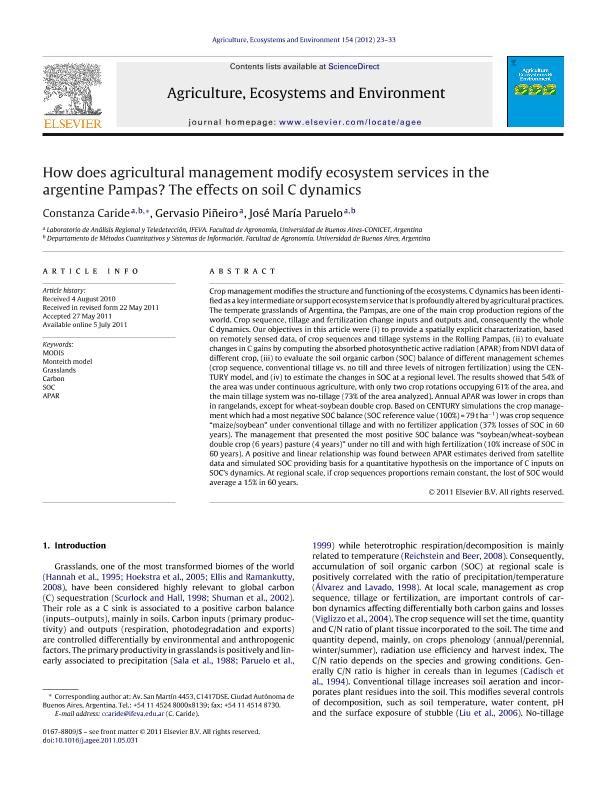Artículo
How does agricultural management modify ecosystem services in the argentine Pampas? The effects on soil C dynamics
Fecha de publicación:
07/2012
Editorial:
Elsevier Science
Revista:
Agriculture, Ecosystems and Environment
ISSN:
0167-8809
Idioma:
Inglés
Tipo de recurso:
Artículo publicado
Clasificación temática:
Resumen
Crop management modifies the structure and functioning of the ecosystems. C dynamics has been identified as a key intermediate or support ecosystem service that is profoundly altered by agricultural practices. The temperate grasslands of Argentina, the Pampas, are one of the main crop production regions of the world. Crop sequence, tillage and fertilization change inputs and outputs and, consequently the whole C dynamics. Our objectives in this article were (i) to provide a spatially explicit characterization, based on remotely sensed data, of crop sequences and tillage systems in the Rolling Pampas, (ii) to evaluate changes in C gains by computing the absorbed photosynthetic active radiation (APAR) from NDVI data of different crop, (iii) to evaluate the soil organic carbon (SOC) balance of different management schemes (crop sequence, conventional tillage vs. no till and three levels of nitrogen fertilization) using the CENTURY model, and (iv) to estimate the changes in SOC at a regional level. The results showed that 54% of the area was under continuous agriculture, with only two crop rotations occupying 61% of the area, and the main tillage system was no-tillage (73% of the area analyzed). Annual APAR was lower in crops than in rangelands, except for wheat-soybean double crop. Based on CENTURY simulations the crop management which had a most negative SOC balance (SOC reference value (100%)=79tha -1) was crop sequence "maize/soybean" under conventional tillage and with no fertilizer application (37% losses of SOC in 60 years). The management that presented the most positive SOC balance was "soybean/wheat-soybean double crop (6 years) pasture (4 years)" under no till and with high fertilization (10% increase of SOC in 60 years). A positive and linear relationship was found between APAR estimates derived from satellite data and simulated SOC providing basis for a quantitative hypothesis on the importance of C inputs on SOC's dynamics. At regional scale, if crop sequences proportions remain constant, the lost of SOC would average a 15% in 60 years. © 2011 Elsevier B.V.
Palabras clave:
Apar
,
Carbon
,
Grasslands
,
Modis
,
Monteith Model
,
Soc
Archivos asociados
Licencia
Identificadores
Colecciones
Articulos(IFEVA)
Articulos de INST.D/INV.FISIOLOGICAS Y ECO.VINCULADAS A L/AGRIC
Articulos de INST.D/INV.FISIOLOGICAS Y ECO.VINCULADAS A L/AGRIC
Citación
Caride, Constanza; Piñeiro, Gervasio; Paruelo, José; How does agricultural management modify ecosystem services in the argentine Pampas? The effects on soil C dynamics; Elsevier Science; Agriculture, Ecosystems and Environment; 154; 7-2012; 23-33
Compartir
Altmétricas




